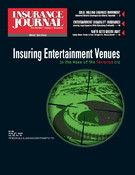Life insurers have driven the push to federalize insurance regulation in part because of the speed-to-market issue—it takes longer for them to roll out new products, as compared to their competitors who are selling financial products aimed at achieving the same long-term goals but are not sold as “insurance.” Another vexing issue at the forefront for this segment of the industry is the cost of market conduct examinations.
One compliance officer for a large national life insurer told Insurance Journal her company had undergone six different examinations in just the last two years. She was attending a mid-May best practices workshop for compliance officers hosted by the Insurance Marketplace Standards Association (IMSA). Another life insurer underwent 19 exams last year, according to IMSA President Gary Eisenbarth, CEO of Oak Brook, Ill.-based MTL Insurance Co. Insurers must foot the bill for the state examiner to do an onsite investigation of the company’s conduct—that is, how it markets its products, encompassing advertisements, agent activities and much more.
IMSA has stepped up its role recently and hopes to lower its members compliance cost through a system of self-regulation. If IMSA can get the states to accept a company’s membership as a sign of good faith and tailor the scope of their examinations accordingly, the life insurance industry may hit on a way to achieve at least some of its goals while the federalization issue lingers in the background.
“IMSA was established as a management tool for companies with protocols and procedures that are expected to be followed,” Executive Director Brian Atchinson told IJ. “There’s a growing sense that regulators are recognizing the positive effects of becoming IMSA qualified.”
“Acceptance among regulators has been slow to come,” Atchinson said, referencing the process of negotiation with individual state insurance departments and the National Association of Insurance Commissioners (NAIC).
The regulatory patchwork, however, means that insurers bear the costs of different standards in different states. According to a 2003 report by the U.S. General Accounting Office, 15 states do only targeted exams, four states do comprehensive exams, 22 states do both and nine states conduct no market exams at all.
“The only consistency in the system is that it’s inefficient,” Atchinson said. “IMSA-qualified companies are trying to do the right thing in all 50 states. State regulation has for too long looked at minutia and missed the big picture.”
Eisenbarth said IMSA’s best practices and protocols should provide the standard either through the NAIC, the National Conference of Insurance Legislators (NCOIL), or federal standards. “IMSA’s principles form a great basis for national standards of compliance and market conduct and best practices,” he said.
While IMSA leaders have visited more than 40 insurance departments, so far only two—Texas and New York—have put IMSA’s role in the market conduct examination process in writing. In those states, membership in IMSA can help determine the scope and structure of a market conduct exam. NCOIL has already passed a market conduct model, but it neither includes a provision deferring regulation to the state of domicile nor to the state where a company has its largest book of business. Some see the model, which the NAIC is likely to emulate, as feckless.
Topics Legislation
Was this article valuable?
Here are more articles you may enjoy.


 ‘Extremely Dangerous’ Hurricane Beryl Takes Aim at Caribbean
‘Extremely Dangerous’ Hurricane Beryl Takes Aim at Caribbean  US Roof Maintenance Lags: Hanover
US Roof Maintenance Lags: Hanover  Microsoft Tells Texas Agencies They Were Exposed in Russian Hack
Microsoft Tells Texas Agencies They Were Exposed in Russian Hack  Supreme Court Overturns Chevron Rule in Blow to Regulators
Supreme Court Overturns Chevron Rule in Blow to Regulators 


